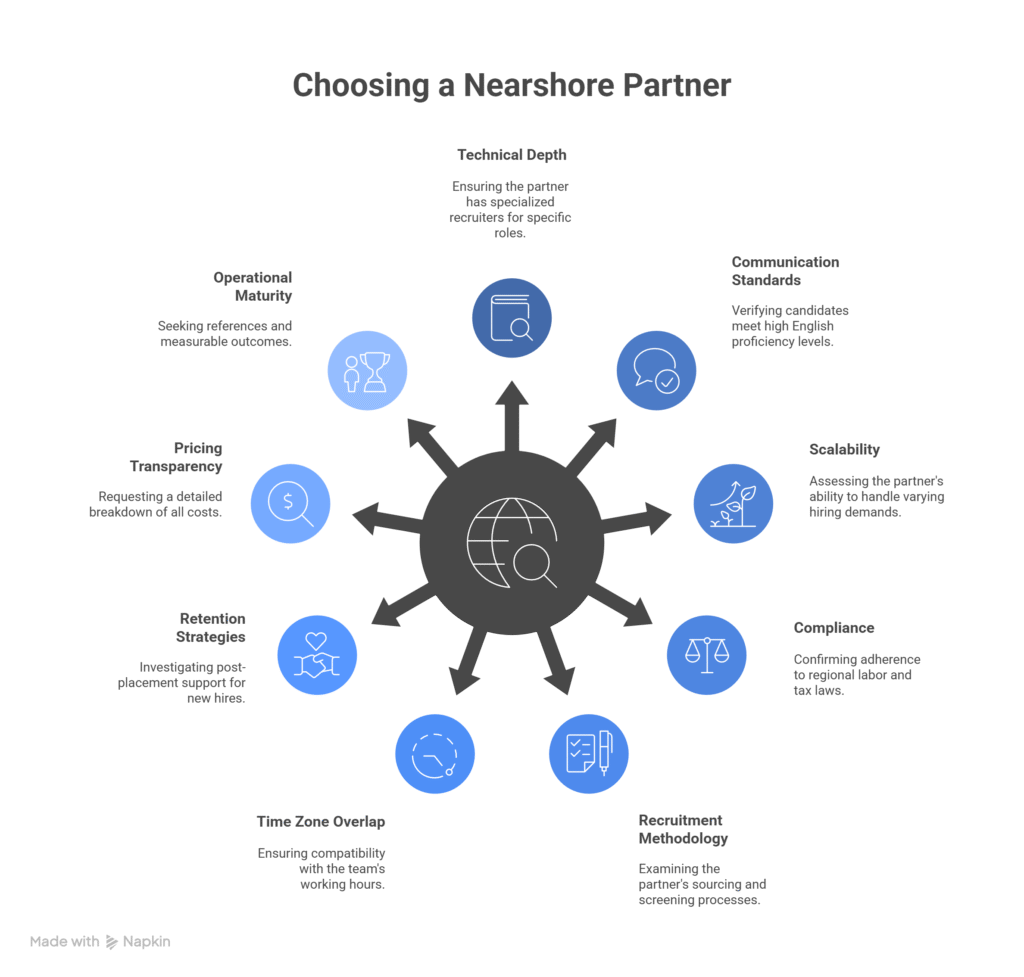Choosing the right nearshore partner can significantly impact your business operations, cost efficiency, and project outcomes. Nearshoring offers US firms access to skilled talent in nearby countries, reducing time zone challenges and improving collaboration. But, finding a partner that aligns with your goals requires careful evaluation of expertise, communication practices, and cultural compatibility.
You need a partner who understands your industry, delivers consistent quality, and adapts to your specific needs. Factors like technical capabilities, scalability, and data security should guide your decision-making process. A well-chosen nearshore partner can streamline workflows and help you stay competitive in today’s market.
Are you ready to discover how to identify the ideal nearshore partner for your firm? Let’s explore key strategies that will simplify this critical choice.
How to Choose the Right Nearshore Partner for U.S. Businesses
Building a nearshore team is easier when you choose a recruitment partner that can operate as an extension of your company. The right agency should understand your business model, match your pace of hiring, and deliver qualified professionals who can execute from day one.
Below is a framework to evaluate nearshore staffing agencies based on what actually impacts outcomes:
1. Evaluate Technical Depth and Industry Specialization
Don’t hire a generalist recruiter to fill specialized roles. Confirm the agency has recruiters dedicated to your vertical — whether you’re hiring engineers fluent in Python, marketers skilled in HubSpot or GA4, or account executives experienced in B2B SaaS sales.
Request proof of past placements, success metrics, and portfolio diversity. A strong nearshore recruitment partner should show documented results hiring for roles like demand generation managers, full-stack developers, or sales development representatives — not just claim “experience.”
2. Audit Communication Standards and English Proficiency
Clear communication is non-negotiable for remote collaboration. Verify that candidates meet C1/C2 English levels and that the agency actively screens for communication maturity, not just technical skill.
Ask to see recordings of candidate interviews or client feedback demonstrating cross-cultural professionalism. The best nearshore agencies enforce communication benchmarks because a technically strong but linguistically weak hire can derail productivity and client relationships.
3. Assess Scalability and Recruitment Infrastructure
Your partner should be built for scale — able to hire one marketer this month or twenty engineers next quarter without a performance dip. Evaluate whether they use structured recruitment pipelines, automated sourcing systems, and distributed recruiter pods segmented by function (marketing, sales, engineering).
If an agency can’t demonstrate operational scalability — including multi-time-zone coordination and ATS-level reporting — it will bottleneck your growth when headcount demands rise.
4. Verify Compliance, Payroll, and Legal Frameworks
Compliance failures are the hidden tax of international hiring. A qualified nearshore staffing agency must understand regional labor codes, tax systems, and social security regulations across Latin America, North Africa, and Eastern Europe.
Confirm they operate through Employer of Record (EOR) entities or trusted legal partners who handle employment contracts, payroll execution, and IP protection. This eliminates exposure to misclassification, unpaid taxes, or labor disputes — issues that can cost more than any recruiter fee.
5. Examine the Recruitment and Vetting Methodology
Ask for full visibility into their recruitment process — from sourcing and skills testing to final shortlisting. Agencies that rely on generic job boards are not delivering value.
The best nearshore recruitment partners use structured, data-driven screening systems, including technical evaluations, communication tests, and behavior-based interviews. This rigor ensures candidates meet U.S. operational standards and can integrate with your internal culture from day one.
6. Prioritize Time Zone Overlap and Process Integration
Time zone compatibility is not a minor detail — it’s the backbone of remote collaboration. Ensure the agency recruits talent from regions that match your team’s working hours (GMT-5 to GMT-7 for U.S. operations).
A partner that understands project management workflows (Slack, Asana, HubSpot, Jira) and guarantees overlap in core hours enables real-time execution rather than asynchronous lag. This is critical when building distributed marketing, sales, or product teams.
7. Evaluate Retention and Talent Lifecycle Management
Retention is the ultimate ROI indicator. Investigate how the agency supports new hires post-placement. Do they manage onboarding? Offer retention bonuses or engagement check-ins? Monitor satisfaction over the first 90 days?
Turnover among remote hires often results from poor onboarding and unclear expectations. A serious nearshore staffing agency will provide structured performance tracking, mentorship frameworks, and engagement programs to ensure longevity and performance consistency.
8. Demand Transparent Pricing and Ownership Clarity
Avoid agencies with vague “placement fees” or hidden markups. Request a detailed breakdown of costs — recruitment, HR administration, payroll, and benefits management.
Ownership clarity is just as important: you should retain full administrative control over accounts, tools, and intellectual property. The best nearshore partners treat transparency as part of governance, not negotiation.
9. Validate Operational Maturity and References
Finally, ask for client references from U.S. companies similar to yours — ideally in headcount, industry, or function. Look for measurable outcomes such as time-to-hire reductions, cost savings, and retention improvements.
Mature partners will provide these metrics upfront because they treat recruitment as a measurable performance function, not a one-off transaction.

Advice When Partnering with a Nearshore Staffing Agency
Prioritize Strategic Alignment Over Price Per Hire
Focusing on strategic alignment ensures long-term success when selecting a nearshore staffing partner. While cost savings are often attractive, prioritizing price over compatibility can lead to inefficiencies, miscommunication, and high turnover rates.
Evaluate the partner’s understanding of your business goals. A nearshore recruitment agency that aligns with your objectives will source talent capable of driving measurable outcomes. For example, if you’re building engineering teams or hiring for marketing roles in Latin America, the provider should demonstrate expertise in recruiting professionals with relevant technical skills and industry experience.
Assess cultural fit and communication standards. Nearshore hires operating within US time zones must integrate seamlessly into your workflows. Look for C1 or C2 English-level LATAM talent to minimize language barriers and enhance collaboration across distributed teams.
Examine their approach to retention planning for remote hires. Retaining full-time nearshore employees requires robust workforce management strategies, including clear career progression paths and competitive salary benchmarks in LATAM markets. High attrition disrupts operations and increases costs associated with rehiring.
Verify compliance capabilities before finalizing agreements. Compliant hiring in Latin America involves navigating local labor laws, payroll regulations, and tax requirements. A reliable partner handles contract-to-hire processes efficiently while ensuring legal adherence to protect your business from liabilities.
Strategic alignment also impacts scalability. Whether you’re scaling teams with nearshore professionals or setting up a nearshore team for long-term growth, choose a partner experienced in managing headcount expansion without compromising quality or delivery timelines.
Avoid partners offering unsustainably low pricing models. Cost-effective hiring without compromising quality is achievable through transparent pricing structures rather than cutting corners on candidate qualifications or operational support functions like onboarding remote hires from Latin America.
By emphasizing strategic compatibility over short-term cost reductions, you position your organization for sustainable growth with fully integrated nearshore teams aligned to your vision and performance expectations.
Validate Track Record in Sales, Marketing, and Engineering Roles
Assessing a nearshore partner’s track record ensures their ability to deliver consistent results. Review case studies or client testimonials that highlight successful placements in sales, marketing, and engineering roles. Look for examples of remote sales teams in LATAM driving revenue growth or marketing professionals executing campaigns aligned with US market standards.
Evaluate the partner’s experience in building engineering teams nearshore by examining project outcomes, timelines, and technical achievements. Partners specializing in hiring C1/C2 English-level professionals demonstrate their capacity to source talent capable of seamless communication with US-based teams.
Request metrics like retention rates for long-term nearshore hires or performance benchmarks achieved by full-time employees placed through their services. A strong history managing remote workforce operations across Latin America reflects expertise in scaling distributed teams effectively.
Verify if they’ve supported clients with compliant hiring practices in Latin America, including contract and payroll management for LATAM talent. This ensures your partnership aligns with legal requirements while minimizing risks tied to cross-border recruiting.
Ask specific questions about how they manage team alignment between US remote teams and LATAM hires. Their approach should include strategies for onboarding remote hires from Latin America and retaining high-performing employees over time.
Prioritize partners who provide transparent insights into their nearshore hiring workflow and staffing processes. Clear documentation on sourcing methods, candidate evaluation criteria, and ongoing support functions signals reliability when setting up a nearshore team for long-term growth.
Ensure Time Zone Overlap and Real-Time Collaboration Capability
Aligning work hours with your nearshore partner ensures seamless communication. US remote teams benefit from overlapping schedules, allowing faster decision-making and reduced delays in project execution. This alignment is especially critical for roles requiring constant interaction, such as engineering teams or remote marketing teams.
Evaluate a partner’s ability to support real-time collaboration tools like Slack or Microsoft Teams. These platforms help instant updates, quick problem resolution, and efficient task management. When hiring full-time nearshore employees, ensure their infrastructure supports uninterrupted connectivity during shared working hours.
Prioritize partners experienced in managing teams across US and LATAM regions. They should demonstrate expertise in setting up a nearshore team for long-term growth by fostering clear workflows and structured communication channels. Ask about their approach to onboarding remote hires from Latin America and how they maintain alignment during cross-border operations.
Ask specific questions about time zone compatibility during the nearshore hiring process. Inquire how they manage performance management for nearshore teams operating simultaneously with US-based staff. A well-aligned schedule combined with robust collaboration practices creates a foundation for scalable success with fully integrated nearshore teams.
Review Talent Vetting Standards and Sourcing Infrastructure
Examine their sourcing infrastructure to understand how they attract candidates. Partners with established pipelines in Latin America often access top-tier engineering teams, marketing specialists, and remote sales professionals. Ask about their strategies for engaging passive candidates and leveraging local networks to source niche talent.
Verify if the partner uses a scalable hiring model to support long-term nearshore hires. A robust system should accommodate headcount expansion without compromising quality. Check whether they specialize in building US timezone remote teams for seamless collaboration.
Request transparency on tools used during recruitment. Platforms enabling efficient candidate tracking, compliance checks, and performance evaluations indicate operational efficiency. Ensure their processes align with compliant hiring practices in Latin America to avoid legal risks when onboarding full-time employees outside the US.
Assess retention-focused strategies within their hiring workflow. High turnover rates disrupt team alignment and increase costs over time. Reliable partners prioritize retention planning by matching candidates’ career goals with your business needs while offering ongoing support for remote workforce management.
Ask specific questions about onboarding workflows for new hires from LATAM regions like Mexico or Colombia. Effective onboarding ensures productivity from day one and minimizes integration challenges across distributed teams.
Demand Transparency in Employer of Record (EOR) and Compliance Ops
Ensure your nearshore staffing partner provides full visibility into their Employer of Record (EOR) services and compliance operations. EORs handle critical functions like payroll, tax filings, benefits administration, and employment contracts for remote hires in Latin America. Without transparency, you risk legal liabilities or non-compliance with local labor laws.
Verify how the partner manages compliant hiring in Latin America. Ask if they ensure adherence to country-specific regulations on worker classification, termination policies, and social security contributions. For example, countries like Mexico and Brazil have strict rules about severance pay and employee protections that can impact long-term nearshore hires.
Request detailed documentation about contract management processes. Confirm whether the partner drafts legally binding agreements aligned with US business standards while respecting LATAM labor codes. This step prevents misaligned expectations when onboarding nearshore employees or scaling teams with full-time nearshore professionals.
Evaluate their approach to payroll accuracy and reporting. Reliable partners offer transparent breakdowns of salary benchmarks in LATAM markets, including taxes, benefits costs, and exchange rate considerations. Inconsistent payroll practices disrupt trust with your remote workforce in Latin America.
Scrutinize retention planning tied to compliance efforts. High turnover rates often stem from inadequate benefit structures or unclear contractual terms. Partners who prioritize performance management for nearshore teams help retain remote employees in LATAM by fostering stability through fair treatment.
Ask direct questions about audit readiness and dispute resolution mechanisms. A trustworthy nearshore recruitment agency should outline steps for handling audits or disputes involving cross-border recruiting activities. Clear protocols protect your company’s reputation during unforeseen challenges.
Analyze Candidate Pipeline Depth by Country and Role
Evaluate the depth of candidate pipelines to ensure your nearshore recruitment strategy aligns with business needs. Focus on specific countries in Latin America, as talent availability varies significantly across regions. For example, Chile and Colombia offer a broad pool of engineering professionals, while Central America and Argentina excel in marketing roles. Understanding these distinctions helps you target locations that align with your hiring priorities.
Assess role-specific expertise when analyzing pipeline strength. For technical hiring in Latin America, prioritize countries known for producing skilled software developers or engineers proficient in US-adjacent technologies like JavaScript, Python, or cloud platforms. If you’re building remote sales teams in LATAM, identify markets where English-speaking professionals with C1/C2 communication levels are abundant.
Consider time zone alignment when evaluating pipeline suitability for US teams. Countries such as Costa Rica and Panama provide excellent overlap for real-time collaboration, making them ideal for roles requiring constant interaction like customer support or project management.
Request data from potential nearshore staffing partners about their active talent pools segmented by country and job function. Ask how they source candidates to determine if their methods include modern strategies like leveraging local tech communities or using AI-driven tools to refine searches. Partners offering transparent insights into their sourcing infrastructure demonstrate operational efficiency and reliability.
Analyze retention rates within the candidate pipelines presented by nearshore recruiting agencies. High turnover disrupts team dynamics and inflates costs over time. Look for partners who emphasize long-term nearshore hires through robust retention planning tied to competitive salary benchmarks in LATAM markets.
Verify compliance coverage during your analysis process. Ensure the partner’s contract-to-hire models meet legal standards in each targeted country to avoid complications later. A compliant hiring framework safeguards operations while supporting scalable growth across distributed teams.
Inspect Onboarding, Ramp-Up, and Retention Processes
Evaluate onboarding workflows to ensure they support seamless integration for nearshore hires. Effective onboarding processes should include clear role definitions, access to necessary tools, and structured training programs tailored for remote team members in Latin America.
Assess ramp-up timelines by reviewing how quickly a nearshore staffing partner enables new hires to reach full productivity. Shorter ramp-up periods often indicate efficient knowledge transfer systems and robust operational frameworks. If you’re hiring nearshore professionals for engineering or marketing roles, ask about their strategies for skill alignment during the initial weeks of employment.
Analyze retention strategies to avoid high turnover rates among long-term nearshore hires. A reliable partner prioritizes performance management for nearshore teams through regular feedback cycles and career development opportunities. Retaining remote employees in LATAM requires competitive compensation aligned with salary benchmarks in the region and ongoing engagement initiatives like virtual team-building activities.
Request data on past success rates from your potential nearshore recruitment agency. Metrics such as average employee tenure and attrition rates provide insights into their ability to maintain stable teams over time. This is especially critical when scaling teams with nearshore professionals or building a distributed workforce across US-adjacent time zones.
Ask targeted questions about how the partner supports remote team alignment post-onboarding. Examples include mechanisms for cross-border collaboration, cultural integration efforts, and tools used for real-time communication within US timezone remote teams. These factors directly impact long-term productivity and employee satisfaction in distributed setups.

Evaluating Operational Maturity of a Nearshore Partner
Operational maturity directly impacts the success of nearshore recruitment. Assessing tools, processes, and team structures ensures your partner can support scalable growth for US businesses.
Platform Integrations: ATS, HRIS, Payroll Systems
Verify that the nearshore staffing partner integrates seamlessly with your existing systems. Applicant Tracking Systems (ATS), Human Resource Information Systems (HRIS), and payroll platforms streamline hiring workflows and compliance management. For example, integration with an ATS enables efficient tracking of candidates during the nearshore hiring process. Similarly, payroll system compatibility simplifies payments for full-time nearshore employees in Latin America while ensuring tax compliance.
Ask about platform flexibility to accommodate future scaling needs. A mature partner should offer solutions compatible with remote-first hiring infrastructure or contract-to-hire models without disrupting operations.
Custom Reporting, SLAs, and Hiring KPIs
Evaluate reporting capabilities to monitor performance metrics critical to nearshore talent acquisition. Custom reports on time-to-fill rates, retention planning for remote hires, and pipeline development by role provide actionable insights into operational efficiency. Service Level Agreements (SLAs) ensure accountability by defining measurable standards like candidate delivery timelines or quality benchmarks.
Request data on hiring KPIs such as interview-to-offer ratios or long-term retention rates for roles like engineering teams nearshore or marketing roles in LATAM. Transparent reporting demonstrates a commitment to meeting your expectations while reducing risks tied to hidden inefficiencies.
Team Structure: Dedicated Recruiters vs Shared Resources
Understand how the partner allocates resources within their team structure. Dedicated recruiters focus exclusively on your account, offering deeper engagement in sourcing C1 English level professionals or managing technical hiring in Latin America. This approach benefits businesses prioritizing specialized roles like dev teams in LATAM or fully integrated nearshore teams.
Shared resources may suit smaller-scale projects but risk delays due to competing priorities across clients. Confirm whether the team setup aligns with your goals for building a distributed team or scaling teams with nearshore professionals efficiently over time.
Country-Level Considerations for US Firms
Selecting the right country for nearshore recruitment impacts your access to talent, compliance processes, and operational efficiency. Evaluate these factors carefully to align with your business goals.
Political Stability, Legal Framework, and IP Protections
Political stability ensures consistent operations without disruptions from government changes or civil unrest. Countries like Mexico, Colombia, and Costa Rica offer stable environments conducive to long-term nearshore staffing. A robust legal framework simplifies compliant hiring in Latin America by ensuring clear labor laws and tax regulations. For example, Mexico’s structured employment laws support transparent payroll management for full-time nearshore employees.
Intellectual property (IP) protections safeguard sensitive data shared during remote team onboarding in LATAM. Countries adhering to international agreements like the Berne Convention or TRIPS provide stronger guarantees against IP theft. Prioritize partners experienced in managing contracts and payroll for LATAM talent while ensuring data security protocols meet US standards.
English Proficiency and Cultural Compatibility
English-speaking remote teams improve communication with US timezone remote teams. Target countries with high C1/C2 English proficiency levels such as Argentina and Chile when hiring for roles requiring advanced language skills like marketing or sales. Hiring professionals with strong English fluency reduces miscommunication risks during cross-border recruiting.
Cultural compatibility enhances collaboration within distributed teams. Shared work ethics, similar holiday schedules, and overlapping time zones make LATAM countries ideal for building a remote team in your time zone. Assess cultural alignment through trial projects or interviews before finalizing hires to ensure smooth integration into your company culture.
Salary Benchmarking Across LATAM Markets
Salary benchmarks vary significantly across Latin American markets due to differences in cost of living and demand for specific skill sets. For instance, software engineers in Brazil command higher salaries compared to those in Peru due to regional competition for tech talent. Use market-specific salary data when planning nearshore headcount expansion.
Cost-effective hiring without compromising quality is achievable by targeting regions offering competitive rates aligned with role requirements. Collaborate with a nearshore recruiting partner who provides detailed compensation insights per country and role type to optimize budgets while retaining top-tier professionals over the long term.
Red Flags to Avoid in Nearshore Partnerships
Identifying potential issues early prevents costly mistakes when working with a nearshore staffing partner. Watch for these red flags during the evaluation process.
Over-Reliance on Freelance Networks
Partners relying heavily on freelance networks often lack control over talent quality and availability. This approach creates inconsistencies in skill levels, making it harder to build cohesive teams for long-term projects. For example, engineering teams may face delays if freelancers are unavailable or underperforming. Prioritize partners with direct access to vetted professionals through established pipelines rather than temporary marketplaces.
Freelance-heavy models also complicate compliance and payroll processes, especially in Latin America. Without compliant hiring structures, you risk legal exposure when managing contracts and payments across borders. A reliable nearshore recruitment agency ensures transparent employment terms and adheres to local labor laws.
Lack of Function-Specific Expertise
Generalist providers without deep expertise in specific roles struggle to meet your business needs. For nearshore recruitment, ensure the partner demonstrates proven success in those areas. Ask about their experience sourcing candidates with English proficiency or technical skills tailored to your industry.
Without function-specific knowledge, partners may present mismatched candidates who fail to align with your operational goals. Evaluate case studies or client testimonials that highlight successful placements for similar positions within US timezone remote teams. A focused nearshore staffing partner delivers higher-quality results by understanding role-specific requirements.
Hidden Fees in Contracts and Payroll
Opaque pricing structures signal potential financial risks when scaling operations with full-time nearshore employees. Partners embedding hidden fees into contracts—such as unexpected onboarding costs or inflated payroll charges—erode trust and inflate budgets unnecessarily.
Request detailed breakdowns of all service fees before signing agreements. Verify whether contract-to-hire models include additional charges beyond initial recruitment services. Transparent pricing ensures cost-effective hiring without compromising quality while safeguarding against budget overruns during team extension efforts.
Hidden fees also disrupt payroll accuracy for distributed teams across Latin America. Confirm that the provider offers clear payroll management systems aligned with regional compliance standards to avoid penalties or disputes later on.
The Partner You Choose Determines the Teams You Build
Selecting the right nearshore partner is a strategic decision that directly impacts your ability to build high-performing, scalable teams. A reliable partner brings more than just talent; they provide expertise, operational transparency, and alignment with your business goals.
By focusing on key factors like technical capabilities, compliance practices, and cultural compatibility, you set the foundation for long-term success. Prioritizing quality over cost ensures sustainable growth while avoiding common pitfalls like hidden fees or mismatched candidates.
The effort you invest in evaluating potential partners pays off through stronger collaboration, streamlined operations, and access to top-tier talent tailored to your needs.
Find the Nearshore Partner Your Business Deserves
Book a Strategic CallFrequently Asked Questions
What is nearshoring, and why is it beneficial for US businesses?
Nearshoring involves outsourcing business processes to nearby countries. For US businesses, it offers benefits like access to skilled talent, reduced time zone differences for better collaboration, cost efficiency, and improved project outcomes.
How do I choose the right nearshore partner?
Evaluate factors such as technical expertise, industry fit, communication skills, scalability options, compliance knowledge, transparent pricing models, and retention strategies. Ensure alignment with your business goals over focusing solely on costs.
Why is time zone alignment important in nearshoring?
Time zone overlap ensures seamless communication and real-time collaboration. This is especially critical for roles requiring constant interaction or quick decision-making within remote teams.
What should I look for in a nearshore partner’s track record?
Review case studies and client testimonials to validate their experience in building engineering teams or managing remote workforce operations. Check their success in sales, marketing, or other relevant roles.
How can I ensure quality hires through a nearshore partner?
Assess the depth of their candidate pipeline by country and role. Request data on sourcing methods and analyze retention rates to ensure long-term hires that align with your needs.
What onboarding practices are essential for nearshore hires?
Effective onboarding includes clear role definitions, access to tools, structured training programs tailored for remote workers, and workflows designed to support smooth integration into your team.
Why is compliance crucial when working with a nearshore partner?
Compliance ensures legal hiring practices across borders while safeguarding intellectual property (IP) rights. Verify the partner’s Employer of Record (EOR) services and contract management capabilities.
How can I avoid hidden fees in nearshore partnerships?
Request detailed pricing structures upfront. Look out for potential hidden costs in contracts or payroll services to maintain financial transparency and accurate budget planning.
What red flags should I watch out for when selecting a nearshore partner?
Avoid partners overly reliant on freelance networks or lacking function-specific expertise. These issues may lead to inconsistent talent quality or mismatched candidates that don’t meet your requirements.
How does cultural compatibility impact remote team success?
Cultural compatibility enhances teamwork by improving communication and understanding among distributed teams. It fosters stronger collaboration between US firms and Latin American professionals.
Should salary benchmarking be considered during recruitment?
Yes! Use market-specific salary data from Latin America to optimize hiring budgets while ensuring you attract high-quality talent without overspending unnecessarily.




